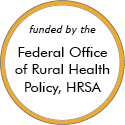Rural Project Examples: Aging and aging-related services
Evidence-Based Examples
StrongPeople® Program
Updated/reviewed July 2024
- Need: Few older adults, particularly women and those in rural areas, participate in healthy living interventions.
- Intervention: Health educators lead community-based healthy living classes, which include strength training, aerobic exercise, dietary skill building, and/or civic engagement, depending on the program.
- Results: StrongPeople® programs have been shown to improve weight, diet, physical activity, strength, cardiovascular health profile, physical function, pain, depression, and/or self-confidence in midlife and older adults.
Fit & Strong!®
Updated/reviewed August 2020
- Need: Osteoarthritis is a chronic condition which often causes multiple related disabilities in older adults.
- Intervention: An 8-week physical activity, behavior change, and falls prevention program geared to older adults with osteoarthritis.
- Results: Participants gained confidence with increased exercise, lessened stiffness, improved joint pain and improved lower extremity strength and mobility.
Effective Examples
Livingston County Help For Seniors

Updated/reviewed May 2020
- Need: Meeting the health needs of geriatric patients in rural Livingston County, New York.
- Intervention: The Help for Seniors program was developed and using its 'vodcasts,' local EMTs were trained in geriatric screening methods and health needs treatment.
- Results: In addition to developing a successful model for educating EMS personnel, the program screened over 1200 individuals and identified various risks among the geriatric population.
Promising Examples
SASH® (Support and Services at Home)
Updated/reviewed April 2025
- Need: In Vermont, the growing population of older adults, coupled with a lack of a decentralized, home-based system of care management, poses significant challenges for those who want to remain living independently at home.
- Intervention: SASH® (Support and Services at Home), based in affordable housing and their surrounding communities throughout the state, works with community partners to help older adults and people with disabilities receive the care they need so they can continue living safely at home.
- Results: Compared to their non-SASH peers, SASH participants have been documented to have better health outcomes, including fewer falls, lower rates of hospitalizations, fewer emergency room visits, and lower Medicare and Medicaid expenditures.
Arkansas Rural Health Partnership Hospital-based Transitional Care Program

Added July 2024
- Need: Solutions for Medicare beneficiaries' post-acute care recovery gaps in Arkansas's southeast Delta Region.
- Intervention: Supported by federal funding and their membership organization, seven hospitals implemented an evidence-supported Critical Access Hospital transitional care model.
- Results: Participating hospitals found a significant increase in swing bed services revenue, an all-cause low readmission rate, high percentage of patients discharged to home or to an assisted living environment, and positive patient satisfaction surveys.
Other Project Examples
Age-Friendly and Dementia-Friendly Winnemucca
Updated/reviewed August 2025
- Need: To educate rural community members about Alzheimer's disease and other dementias and to support older adults with dementia and caregivers in need.
- Intervention: A community group formed in Winnemucca, Nevada, to discuss topics like health, housing, social events, community improvement, education, and transportation for older adults. The group also provides outreach to older adults, caregiver support, and a variety of educational activities and events.
- Results: The group's efforts have led to many changes for community welfare and safety as well as opportunities for education and activities.
CAPABLE (Community Aging in Place—Advancing Better Living for Elders)
Updated/reviewed July 2025
- Need: To help older adults age in place.
- Intervention: For four to five months, CAPABLE participants receive home visits from a registered nurse, occupational therapist, and home repair services.
- Results: There are currently 38 CAPABLE sites across the country, 19 of which are located in rural communities.
Rural Aging Action Network
Updated/reviewed January 2025
- Need: To connect isolated older adults and family caregivers in rural Minnesota, Montana, North Dakota, and South Dakota to services and supports so they can age in place.
- Intervention: The Rural Aging Action Network is a national collaborative of organizations that mobilize whole communities to address gaps in care for older adults and family caregivers.
- Results: Since 2022, the collaborative has reached over 600 older adults and over 100 family caregivers living in rural communities.
Hospital2Home
Updated/reviewed April 2024
- Need: To prevent hospital readmissions and improve the recovery process for older adults in rural southern Ohio.
- Intervention: Hospital2Home identifies individuals who have an elevated risk of hospital readmission and provides vouchers for services like personal care and home-delivered meals.
- Results: In each of the seven years the program has been in operation, over 85% of participants have avoided readmission in the first two months after hospital discharge.
Geezers, Gulpers, and Gardeners
Updated/reviewed September 2022
- Need: Suicide rates among men age 65 and older have been rising in North Carolina. Challenges include losing friends, illnesses, and the loss of independence – all of which can lead to isolation and depression.
- Intervention: The Chatham County Council on Aging of North Carolina started Geezers, Gulpers, and Gardeners (3G Group) to connect retired men in need of male friends and mutual support.
- Results: Men in similar stages of life and varying backgrounds are forming friendships, engaging in activities, and taking care of their mental health.
For examples from other sources, see:
